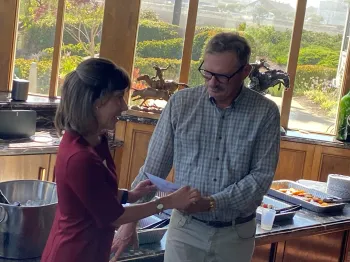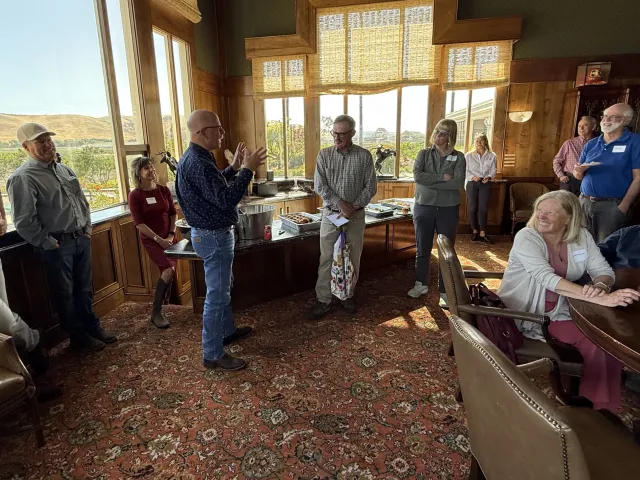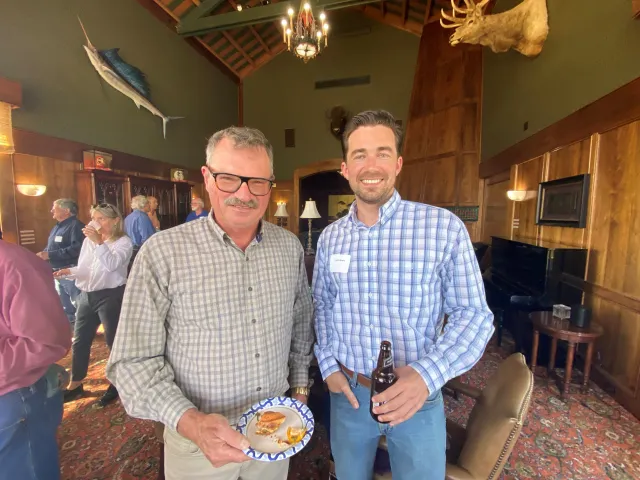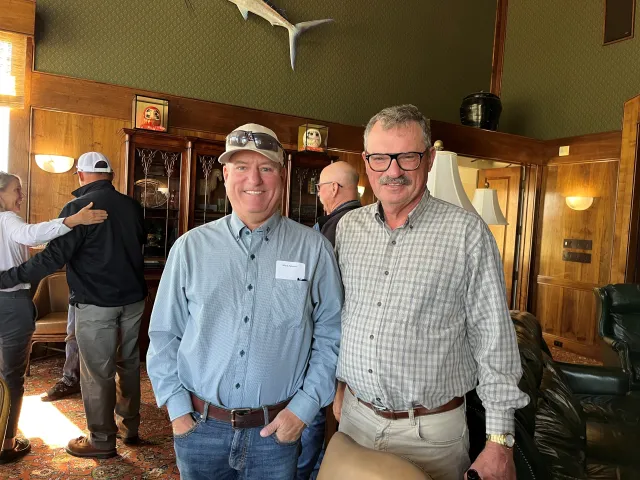
“Take risks,” retiring weed scientist says
Weed scientist Steve Fennimore has retired after 28 years with the UC Davis Department of Plant Sciences. But, retirement only marks the beginning of a new chapter, as he embarks on a venture melding agriculture with engineering to pursue chemical-free soil preparation for strawberries and other specialty crops.
“This has been a great job because you get exposed to so many people,” said Fennimore, until recently a professor of Cooperative Extension based in Salinas, Calif. “There are so many things going on.”

His many contributions to the field were honored recently by the California Leafy Greens Research Board, established by the state in 1973 and funded by growers. Jennifer Clarke, the board’s research program director, thanked Fennimore for his decades of commitment to solving weed problems and exploring non-chemical approaches, such as his soil-steaming machine that kills weed seeds and fungus.
“He was very successful in helping start-up companies making their (automated) technologies better fit growers' needs,” Clarke wrote. “His steam machine not only is a promising solution for weeds, but also for soil-borne diseases.”
When Fennimore was growing up on his family’s farm in the Willamette Valley of Oregon, agriculture was very different. “The year I was born, my grandpa had to teach my dad how to manage a horse,” Fennimore said. The family raised snap beans that climbed along cotton strings to a trellis above, and strawberries for freezing – think Knudson ice cream.
“My gosh, strawberries attract weeds!” Fennimore recalled. “We didn’t fumigate, we just planted them. We weeded them six to eight times in the course of a season.”
Finding solutions to all that backbreaking work felt satisfying, and so began a lifelong passion. Fennimore earned a master’s degree from UC Davis in 1983, then pursued a doctorate at Purdue University in Indiana before returning to Davis in 1997.
We asked Fennimore to reflect on his career.

Q: How has your field changed since you began?
“Mechanization,” Fennimore replied. “Weed science for years has been based on herbicides… They’re still available and they’re quite good, but they only control about 50 percent of the weeds in lettuce.”
How to manage the other half, as workers grow scarce and labor costs rise? The trend toward automated weed control in California started in 2007, when Fennimore and Richard Smith, a UCCE farm advisor (now emeritus), traveled to Germany and saw an “intelligent cultivator.”
“Six months later, we were testing it here,” Fennimore recalled. “After that, it took off… Finally, U.S. industries got involved. Things improved dramatically, making products that fit our system.”
He gave an example: “The laser weeder. You see a little puff of smoke, and the weed is killed. That’s happened just in the last three years.”
Without automated technology, weeding is expensive, costing up to $5,000-an-acre-plus in organic strawberries. “You go through weeding once a month or more. In organics, also, that’s the real payoff.”

Q: What do you consider your most important contribution to your field?
“Developing an herbicide program that’s safe for strawberries,” Fennimore said. By the 1990s, concerns were growing about the environmental impact of the fumigant methyl bromide, which is very effective at controlling both weeds and soil-borne diseases. It was an especially useful tool in strawberries, but was found to deplete protective ozone in Earth’s atmosphere.
Fennimore worked with herbicide companies to develop alternative products that could be used in combination to do the job. Manufacturers finally registered and released GoalTender (Nufarm, of Australia), Chateau (Sumitomo Chemical Company Ltd., of Japan) and Prowl H2O (BASF SE, of Germany).
“That’s the proper way to do pest management, not to do it with one treatment (as with methyl bromide). That’s how you get pest resistance,” Fennimore said. “This is proper pest management: multiple tools, many options…
“We did all this research in 2001 through 2004,” he continued. “We developed the system, verified it works. We tested it in a public setting, showed the growers what the plants looked like, the data.
“We developed an Extension short course in English and Spanish and gave it in all the strawberry areas,” he added.
And just in time: In 2005, California banned the use of methyl bromide in most agricultural settings, though it’s still used in plant production nurseries, Fennimore said.

Q: Is there something else you have done that is especially meaningful to you?
“Steam,” Fennimore replied.
Fennimore has pursued developing a machine that kills soil pests by injecting steam (see related story). This is the passion project that is inspiring him now. The use of steam dates to the 1880s, and it works, so he wants to find a way to make it practical at field scale, he said.
“I love Extension, but I wanted to do something different,” Fennimore added. “I got permission from the (UC Davis) provost’s office back in 2023 to start. We built that machine for vegetables with private funding, and we’re building one for strawberries right now. We’re talking now about design changes. Engineering is hands-on. Every day, a new decision.
“I’m doing what I can to pass this along and scale things up.”
Q: What are the greatest challenges facing your field today?
“Labor, high costs, water quality, regulation,” Fennimore replied. “One grower said, ‘The only way I can increase my profit is to cut my costs.’”
Investment in automated technology can cost well over a million dollars for some machinery. And yet, the return on investment is there for some operations, Fennimore said (see related story).

Q: What advice would you give to someone starting out in this field?
“Don’t be afraid to fail, to take risks, because that’s our job,” Fennimore counseled. “Don’t be intimidated. I’m not an engineer, but that doesn’t stop me (from pursuing the steam project). I don’t understand the flow dynamics, but I understand how to use machinery and how to set goals.”
For those farther along in their careers, he added this: “In the last several years of your career, we need to take significant risks. Try something you’re not sure is going to work, but it’s a high-risk-high-gain activity. That’s where I am with steam.
“Although my wife has set limits.”
Q: What advice would you give to leadership to advance the field?
Funding for weed control in specialty crops such as strawberries goes mainly for pesticide research, Fennimore noted. “Getting the product from the research plot to a labelled product that the grower can use requires years of research” to ensure safety to crops and consumers, he noted.
“What about non-pesticide approaches?” Fennimore asked, advocating for more federal and university investment and support at the intersection of agriculture and engineering. “Federal funding for public researchers to develop engineering solutions to pest management is inadequate. Most machine technology is funded in the private sector.
“My question to UC administrators and U.S. government authorities is: ‘Do we want public researchers to participate in developing technology, even if it is expensive?’...
“Engineers aren’t trained in weed science, and weed scientists are not trained in engineering,” Fennimore added. “That’s the problem I see. The two need to be put together… We need to support people that want to do engineering who are not engineers…
“Younger colleagues get it. That’s going to change. But the federal government needs to pay more attention to this,” Fennimore advised. “You have to support higher education institutions.”
Related links
Read more about Fennimore's steam technology here and here.
Read about machinery to control weeds that was demonstrated at the 2024 Automated Technology Field Day.
Read about using lasers to zap weeds in an orchard.
Read about the California Leafy Greens Research Board.
This article was first published on the UC Davis Department of Plant Sciences site.

